Experience Tumblr like never before
Marine Science - Blog Posts
Algal Gatia aka Algatia

In reference to the au design I made of Nematocyt Girlfriend, heres my sona as an algal/algae cell!!
Not much to say other then that I just felt like doodling myself within my oen au I created. Also funfact th at I nickname each of an au/universe version of myself and such.
I still need a cool name for the au damn
Packing for a Journey into the Twilight Zone
Submitted for your consideration: A team of researchers from more than 20 institutions, boarding two research vessels, heading into the ocean’s twilight zone.
The twilight zone is a dimly lit region between 650 and 3300 feet below the surface, where we’re unfolding the mystery of how tiny ocean organisms affect our planet’s climate.

These tiny organisms – called phytoplankton – are plant-like and mostly single-celled. They live in water, taking in carbon dioxide and releasing oxygen.

Two boats, more than 100 researchers from more than 20 partner institutions, and a whole fleet of robotic explorers make up the EXport Processes in the Ocean from RemoTe Sensing (EXPORTS) team. We’re learning more about what happens to carbon dioxide after phytoplankton digest it.

The Equipment to Find Phytoplankton

Phytoplankton have predators in the ocean called zooplankton. They absorb the phytoplankton’s carbon, carrying it up the food chain. The EXPORTS mission will focus partly on how that happens in the ocean’s twilight zone, where some zooplankton live. When phytoplankton die, sometimes their bodies sink through the same area. All of this carries carbon dioxide into the ocean’s depths and out of Earth’s atmosphere.

Counting Life
Studying the diversity of these organisms is important to better understand what’s happening to the phytoplankton as they die. Researchers from the Virginia Institute of Marine Science are using a very fine mesh net to sample water at various depths throughout the ocean to count various plankton populations.

Researchers from the University of Rhode Island are bringing the tools to sequence the DNA of phytoplankton and zooplankton to help count these organism populations, getting a closer look at what lives below the ocean’s surface.

Science at 500 Feet
Taking measurements at various depths is important, because phytoplankton, like plants, use sunlight to digest carbon dioxide. That means that phytoplankton at different levels in the ocean absorb and digest carbon differently. We’re bringing a Wirewalker, an instrument that glides up and down along a vertical wire to take in water samples all along its 500-foot long tether.

This journey to the twilight zone will take about thirty days, but we’ll be sending back dispatches from the ships. Follow along as we dive into ocean diversity on our Earth Expeditions blog: https://blogs.nasa.gov/earthexpeditions.
Make sure to follow us on Tumblr for your regular dose of space: http://nasa.tumblr.com.

AFRICAN PENGUINS IDENTIFY PATNERS BY THEIR CHEST DOTS
Birds are known to be highly social and visual animals, and penguins are not the exception, as they live in dense colonies. Yet no specific visual feature has been identified to be responsible for individual recognition in birds. Now, researchers demonstrate that african penguins (Spheniscus demersus) can recognize their each others using their ventral dot patterns.
Researchers placed a experiment at the Zoomarine Marine Park, in Rome, Italy, to test how penguins will react to a model with plain with no dot penguin, and to penguins with dots, to find out penguins actually could visually recognize the dots of their lovers and friends in the zoo.
Penguins rely strongly on their ventral dot patterns for individual recognition, and may have holistic representations of other penguins in the colony. In this video below, an african penguin named Gerry appears to recognize his mate, Fiorella (left), in an individual recognition experiment.
These findings suggest that african penguins may rely on a more holistic visual representation of their partner, which includes both the ventral dot patterns and their partner's facial features. Notably, these abilities are not dependent on the ability of a pair to produce offspring together. Nemo and Chicco, male partners, showed the same preference for each other as other penguin partner pairs, suggesting that the ability to distinguish the partner from others is driven simply by the special bond developed between nesting partners.
Photo: Few members of the Zoomarine Italia penguin colony. Unique ventral dot patterns are visible on each penguin's chest. Photo: Cristina Pilenga.
Baciadonna et al., 2024. African penguins utilize their ventral dot patterns for individual recognition. Animal Behaviour.
This past weekend marked the first anniversary of the launch of NASA’s latest ocean color satellite, PACE 🛰️! Happy birthday PACE!

Sharpening Our View of Climate Change with the Plankton, Aerosol, Cloud, ocean Ecosystem Satellite
As our planet warms, Earth’s ocean and atmosphere are changing.
Climate change has a lot of impact on the ocean, from sea level rise to marine heat waves to a loss of biodiversity. Meanwhile, greenhouse gases like carbon dioxide continue to warm our atmosphere.
NASA’s upcoming satellite, PACE, is soon to be on the case!
Set to launch on Feb. 6, 2024, the Plankton, Aerosol, Cloud, ocean Ecosystem (PACE) mission will help us better understand the complex systems driving the global changes that come with a warming climate.

Earth’s ocean is becoming greener due to climate change. PACE will see the ocean in more hues than ever before.
While a single phytoplankton typically can’t be seen with the naked eye, communities of trillions of phytoplankton, called blooms, can be seen from space. Blooms often take on a greenish tinge due to the pigments that phytoplankton (similar to plants on land) use to make energy through photosynthesis.
In a 2023 study, scientists found that portions of the ocean had turned greener because there were more chlorophyll-carrying phytoplankton. PACE has a hyperspectral sensor, the Ocean Color Instrument (OCI), that will be able to discern subtle shifts in hue. This will allow scientists to monitor changes in phytoplankton communities and ocean health overall due to climate change.

Phytoplankton play a key role in helping the ocean absorb carbon from the atmosphere. PACE will identify different phytoplankton species from space.
With PACE, scientists will be able to tell what phytoplankton communities are present – from space! Before, this could only be done by analyzing a sample of seawater.
Telling “who’s who” in a phytoplankton bloom is key because different phytoplankton play vastly different roles in aquatic ecosystems. They can fuel the food chain and draw down carbon dioxide from the atmosphere to photosynthesize. Some phytoplankton populations capture carbon as they die and sink to the deep ocean; others release the gas back into the atmosphere as they decay near the surface.
Studying these teeny tiny critters from space will help scientists learn how and where phytoplankton are affected by climate change, and how changes in these communities may affect other creatures and ocean ecosystems.

Climate models are one of our most powerful tools to understand how Earth is changing. PACE data will improve the data these models rely on.
The PACE mission will offer important insights on airborne particles of sea salt, smoke, human-made pollutants, and dust – collectively called aerosols – by observing how they interact with light.
With two instruments called polarimeters, SPEXone and HARP2, PACE will allow scientists to measure the size, composition, and abundance of these microscopic particles in our atmosphere. This information is crucial to figuring out how climate and air quality are changing.
PACE data will help scientists answer key climate questions, like how aerosols affect cloud formation or how ice clouds and liquid clouds differ.
It will also enable scientists to examine one of the trickiest components of climate change to model: how clouds and aerosols interact. Once PACE is operational, scientists can replace the estimates currently used to fill data gaps in climate models with measurements from the new satellite.

With a view of the whole planet every two days, PACE will track both microscopic organisms in the ocean and microscopic particles in the atmosphere. PACE’s unique view will help us learn more about the ways climate change is impacting our planet’s ocean and atmosphere.
Stay up to date on the NASA PACE blog, and make sure to follow us on Tumblr for your regular dose of sPACE!
Pyrosome passing through #ClearAPathPeople
Pyrosomes are colonial tunicates made up of thousands of individuals known as zooids. Each zooid is housed in the common gelatinous tunic that makes up the larger cylindrical “body” of the pyrosome. Zooids filter phytoplankton through branchial baskets by creating feeding currents through the tunic. Although each zooid is only a couple of millimeters in size, pyrosomes can reach up to several meters in length. While alive, these organisms spend the majority of their time in the upper water column, but their remains have been found as deep as 4,000 meters (13,120 feet), where they provide food for a variety of deep-sea animals.
Pyrosomes are bioluminescent, producing brilliant blue-green light. Each zooid can detect light and emit light in response, creating waves of bioluminescence up and down the organism’s body. The bioluminescence of one pyrosome can trigger others in surrounding waters, producing beautiful light shows. The name Pyrosoma comes from the Greek term meaning “fire body.”
Anyone else love squids as much as we do? (Qeue slow-motion tentacle-raise) 🙋🏻
Galiteuthis phyllura, also known as the cockatoo squid, lives in the North Pacific from 200 to over 1,000 meters (660 to 3,280 feet) deep. This species has a transparent body and photophores, or light organs, under their eyes. We often encounter them hanging horizontally in the water column with their arms raised above their heads.
Meet MBARI: This team develops innovative new technology to map the seafloor 🤖🗺️
With marine life and ecosystems facing a rising tide of threats, the ocean exploration community needs nimble, cost-effective tools for measuring and monitoring ocean health. MBARI’s Control, Modeling, and Perception of Autonomous Systems Laboratory, known as the CoMPAS Lab is up to the challenge.
MBARI scientists and engineers build and adapt advanced technology that enhances ocean data collection. Led by engineer Giancarlo Troni, the CoMPAS Lab team develops scalable marine technology that can easily be modified for use in a wide variety of vehicles and platforms.

Working with other teams across MBARI, the CoMPAS Lab leverages vehicles like the MiniROV to deploy and test new tools in Monterey Bay's submarine canyon and then adapt them for other mobile platforms. By sharing open-source design specifications and advanced algorithms with the wider ocean exploration community, we hope to expand access to MBARI’s engineering innovations.
MBARI technology is transforming what we know about the ocean and its inhabitants. Our scientists, engineers, and marine operations staff work together to create innovative tools for a more sustainable future where autonomous robots and artificial intelligence can track ocean health in real time and help us visualize ocean animals and environments. Studying our blue backyard is revealing our connection to the ocean—how it sustains us and how our actions on land may be threatening its future.

We’re spotlighting various teams at MBARI to showcase the different ways we’re studying the largest environment on Earth. We hope this series inspires a new generation of ocean explorers. Dive in.
Next month will be the one year anniversary of the PACE launch!

Sharpening Our View of Climate Change with the Plankton, Aerosol, Cloud, ocean Ecosystem Satellite
As our planet warms, Earth’s ocean and atmosphere are changing.
Climate change has a lot of impact on the ocean, from sea level rise to marine heat waves to a loss of biodiversity. Meanwhile, greenhouse gases like carbon dioxide continue to warm our atmosphere.
NASA’s upcoming satellite, PACE, is soon to be on the case!
Set to launch on Feb. 6, 2024, the Plankton, Aerosol, Cloud, ocean Ecosystem (PACE) mission will help us better understand the complex systems driving the global changes that come with a warming climate.

Earth’s ocean is becoming greener due to climate change. PACE will see the ocean in more hues than ever before.
While a single phytoplankton typically can’t be seen with the naked eye, communities of trillions of phytoplankton, called blooms, can be seen from space. Blooms often take on a greenish tinge due to the pigments that phytoplankton (similar to plants on land) use to make energy through photosynthesis.
In a 2023 study, scientists found that portions of the ocean had turned greener because there were more chlorophyll-carrying phytoplankton. PACE has a hyperspectral sensor, the Ocean Color Instrument (OCI), that will be able to discern subtle shifts in hue. This will allow scientists to monitor changes in phytoplankton communities and ocean health overall due to climate change.

Phytoplankton play a key role in helping the ocean absorb carbon from the atmosphere. PACE will identify different phytoplankton species from space.
With PACE, scientists will be able to tell what phytoplankton communities are present – from space! Before, this could only be done by analyzing a sample of seawater.
Telling “who’s who” in a phytoplankton bloom is key because different phytoplankton play vastly different roles in aquatic ecosystems. They can fuel the food chain and draw down carbon dioxide from the atmosphere to photosynthesize. Some phytoplankton populations capture carbon as they die and sink to the deep ocean; others release the gas back into the atmosphere as they decay near the surface.
Studying these teeny tiny critters from space will help scientists learn how and where phytoplankton are affected by climate change, and how changes in these communities may affect other creatures and ocean ecosystems.

Climate models are one of our most powerful tools to understand how Earth is changing. PACE data will improve the data these models rely on.
The PACE mission will offer important insights on airborne particles of sea salt, smoke, human-made pollutants, and dust – collectively called aerosols – by observing how they interact with light.
With two instruments called polarimeters, SPEXone and HARP2, PACE will allow scientists to measure the size, composition, and abundance of these microscopic particles in our atmosphere. This information is crucial to figuring out how climate and air quality are changing.
PACE data will help scientists answer key climate questions, like how aerosols affect cloud formation or how ice clouds and liquid clouds differ.
It will also enable scientists to examine one of the trickiest components of climate change to model: how clouds and aerosols interact. Once PACE is operational, scientists can replace the estimates currently used to fill data gaps in climate models with measurements from the new satellite.

With a view of the whole planet every two days, PACE will track both microscopic organisms in the ocean and microscopic particles in the atmosphere. PACE’s unique view will help us learn more about the ways climate change is impacting our planet’s ocean and atmosphere.
Stay up to date on the NASA PACE blog, and make sure to follow us on Tumblr for your regular dose of sPACE!
Diatoms: Algae in glass houses
Check out my new post!
http://becausephytoplankton.blogspot.com/2018/09/diatoms-algae-in-glass-houses.html
Very cool. My lab group also works with Emiliania huxleyi and EhVs.
Don’t underestimate the importance of phytoplankton!

9 Ocean Facts You Likely Don’t Know, but Should
Earth is a place dominated by water, mainly oceans. It’s also a place our researchers study to understand life. Trillions of gallons of water flow freely across the surface of our blue-green planet. Ocean’s vibrant ecosystems impact our lives in many ways.
In celebration of World Oceans Day, here are a few things you might not know about these complex waterways.
1. Why is the ocean blue?

The way light is absorbed and scattered throughout the ocean determines which colors it takes on. Red, orange, yellow,and green light are absorbed quickly beneath the surface, leaving blue light to be scattered and reflected back. This causes us to see various blue and violet hues.
2. Want a good fishing spot?

Follow the phytoplankton! These small plant-like organisms are the beginning of the food web for most of the ocean. As phytoplankton grow and multiply, they are eaten by zooplankton, small fish and other animals. Larger animals then eat the smaller ones. The fishing industry identifies good spots by using ocean color images to locate areas rich in phytoplankton. Phytoplankton, as revealed by ocean color, frequently show scientists where ocean currents provide nutrients for plant growth.
3. The ocean is many colors.

When we look at the ocean from space, we see many different shades of blue. Using instruments that are more sensitive than the human eye, we can measure carefully the fantastic array of colors of the ocean. Different colors may reveal the presence and amount of phytoplankton, sediments and dissolved organic matter.
4. The ocean can be a dark place.
About 70 percent of the planet is ocean, with an average depth of more than 12,400 feet. Given that light doesn’t penetrate much deeper than 330 feet below the water’s surface (in the clearest water), most of our planet is in a perpetual state of darkness. Although dark, this part of the ocean still supports many forms of life, some of which are fed by sinking phytoplankton.
5. We study all aspects of ocean life.

Instruments on satellites in space, hundreds of kilometers above us, can measure many things about the sea: surface winds, sea surface temperature, water color, wave height, and height of the ocean surface.
6. In a gallon of average sea water, there is about ½ cup of salt.

The amount of salt varies depending on location. The Atlantic Ocean is saltier than the Pacific Ocean, for instance. Most of the salt in the ocean is the same kind of salt we put on our food: sodium chloride.
7. A single drop of sea water is teeming with life.

It will most likely have millions (yes, millions!) of bacteria and viruses, thousands of phytoplankton cells, and even some fish eggs, baby crabs, and small worms.
8. Where does Earth store freshwater?

Just 3.5 percent of Earth’s water is fresh—that is, with few salts in it. You can find Earth’s freshwater in our lakes, rivers, and streams, but don’t forget groundwater and glaciers. Over 68 percent of Earth’s freshwater is locked up in ice and glaciers. And another 30 percent is in groundwater.
9. Phytoplankton are the “lungs of the ocean”.

Just like forests are considered the “lungs of the earth”, phytoplankton is known for providing the same service in the ocean! They consume carbon dioxide, dissolved in the sunlit portion of the ocean, and produce about half of the world’s oxygen.
Want to learn more about how we study the ocean? Follow @NASAEarth on twitter.
Make sure to follow us on Tumblr for your regular dose of space: http://nasa.tumblr.com.
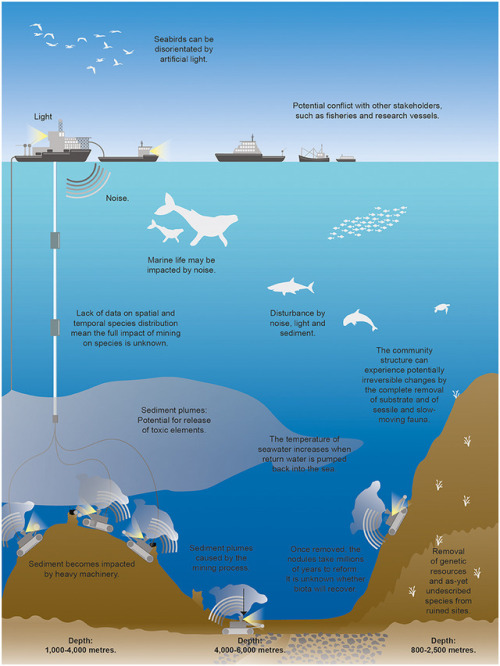
DEEP-SEA MINING COULD DESTROY MARINE ECOSYSTEMS
Despite deep-sea environments covers about half of the Earth’s surface and is home to a vast range of species, little is known about these environments, and mining could have long-lasting and unforeseen consequences, not just at mining sites but also across much larger areas.
According to a study published in scientific journal Frontiers in Marine Science, which is the first to give a global overview of all current plans to mine the seabed, in both national and international waters, and looks at the potential impacts including physical destruction of seabed habitats, creation of large underwater plumes of sediment and the effects of chemical, noise and light pollution arising from mining operations.
Rising demand for minerals and metals, including for use in the technology sector, has led to a resurgence of interest in exploration of mineral resources located on the seabed. Such resources, whether seafloor massive sulfides around hydrothermal vents, cobalt-rich crusts on the flanks of seamounts or fields of manganese nodules on the abyssal plains, cannot be considered in isolation of the distinctive, in some cases unique, assemblages of marine species associated with the same habitats and structures.
Some operations are already taking place, generally at relatively shallow depths near national coastlines. The first commercial enterprise, expected to target mineral-rich sulfides in deeper waters, at depths between 1,500 and 2,000 m on the continental shelf of Papua New Guinea, is scheduled to begin early in 2019.
Illustration: A schematic showing the potential impacts of deep-sea mining on marine ecosystems. Schematic not to scale.
Reference: Miller et al., 2018. An Overview of Seabed Mining Including the Current State of Development, Environmental Impacts, and Knowledge Gaps. Frontiers in Marine Science.


Basket Star
Gorgonocephalus caputmedusae
The Basket Star is a strange yet elegant creature that lives in the deep ocean. It resembles a flesh white ball with gnarled and swirling branches. It thrives in locations with strong currents. Its numerous arms move slowly and wrap around prey. They are one of my favorite animals from the Echinodermata phylum.
Photo credit
https://link.springer.com/article/10.1007/s00227-005-0032-3
https://en.wikipedia.org/wiki/Gorgonocephalus


Helmet Jelly
Periphylla periphylla
The Helmet Jelly can be found at all depths of the ocean. This vibrant and strange jellyfish tends to proliferate in Norwegian fjords. They are one of the dominant predators in these isolated ecosystems.
Photos
http://www.seawater.no/fauna/cnidaria/periphylla.html
https://www.bigfishexpeditions.com/2019/01/24/norway-deepwater-shark-diving-2018/helmet-jelly/

Squarenose Helmetfish
Scopelogadus beanii
The Squarenose Helmetfish is found between 800m to 4000m in the ocean. It received this unique name due to its scales reminding scientists of an armored helmet worn by medieval knights. It also has unusual holes around its face, and the white strands covering its face are sensory canals.
Photo credit: https://www.vistaalmar.es/especies-marinas/peces-extranos/449-que-peces-mas-extranos.html

Periphyllopsis braueri
The Periphyllopsis braueri is a tiny, deep sea jellyfish that is only 6 cm in diameter. It is red-chocolate in color, and it has eight gonads. Furthermore, it is found at depths between 600m to 1000m.
Photo credit: https://oceanexplorer.noaa.gov/explorations/19gulfofalaska/logs/aug2/aug2.html
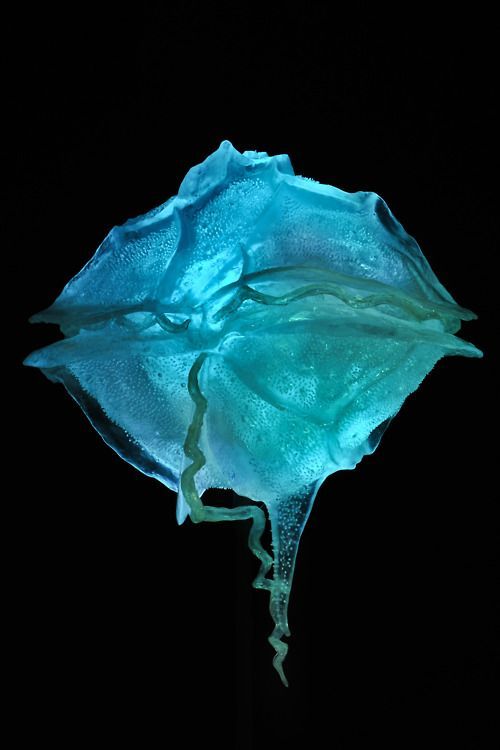

Pyrodinium bahamense
Pyrodinium bahamense is a tropical species of dinoflagellates that is found primarily in Atlantic Ocean waters. It prefers salinity around 20 psu and blooms when there are large amounts of nitrogen in the water. The dinoflagellate glows bright blue when agitated by motion. Furthermore, even though this plankton species is beautiful to look at, it causes seafood toxicity.
Photo credit: https://alchetron.com/Pyrodinium-bahamense
https://wonderchews.com/bodies-of-light/


Sea elephant
Carinaria japonica
The Sea Elephant is a translucent sea snail that has a large muscular body and a tiny triangular shell. Its foot is used for crawling on the ground, and it can be transformed into a fin that is used for swimming. It is called the “sea elephant” because it has a small trunk in its mouth that is used to swallow prey. Furthermore, the Sea Elephant eats arrow worms and jellies.
Photo credit
https://bodegahead.blogspot.com/2014/12/carinaria-part-2.html
http://tolweb.org/Carinaria_japonica/28750


Deep Sea Arrow Worm
Eukrohnia hamata
Arrow worms are small, predatory marine worms that consume copepods, ostracods, and larvae. They resembles a clear, ink pen whizzing through the dark sea. Furthermore, they are found primarily in the Artic Ocean between 700m to 1200m. The picture on the bottom is its head. They have 8 hooks, which are used to grab prey and 25 posterior teeth. Even though the arrow worms are terrifying up close, they are only 4.5 cm in size.
Photo credit: http://www.arcodiv.org/watercolumn/chaetognaths/Eukrohnia_hamata.html

Crystal Jellyfish
Aequorea victoria
The Crystal Jellyfish is a graceful, transparent jellyfish with long, thin tentacles. It has bioluminescent organs around it bell that produce a bright, green light. It tends to consume small copepods, but it has the ability to swallow other jellyfish half its size. Furthermore, this jelly is used in biological experiments to detect calcium.
Photo credit: https://www.montereybayaquarium.org/animals/animals-a-to-z/crystal-jelly
https://fineartamerica.com/featured/5-aequorea-crystal-jellyfish-with-amphipods-alexander-semenovscience-photo-library.html


Physonect Siphonophore
Nanomia cara
The Physonect siphonophore has tiny, bubble shaped sacs that are filled with gas. The sacs are called pneumatophores and help this creature move through the deep ocean. It also has venomous tentacles that stun prey and over eighty stomachs. There are numerous amounts of these strange creatures along the east coast, and they have cause some fisheries to collapse. Furthermore, they can be found at depth between 400m to 1000m.
Photo credit: http://www.seawater.no/fauna/cnidaria/cara.html
https://www.mindenpictures.com/stock-photo-siphonophore-hydrozoan-cnidarian-nanomia-cara-atlantic-nectophores-naturephotography-image90194961.html


Sea Gooseberry
Pleurobrachia pileus
The Sea Gooseberry is a comb jelly or ctenophore that has two enormous tentacles covered with adhesive cells. When tiny crustaceans, eggs, and larvae brush against the tentacles, the prey are stuck to them. The Sea Gooseberry draws the tentacles to its mouth, and it consumes the prey. These unique organisms can be found as deep as 750 m.



Black Dragonfish
Idiacanthus atlanticus
The Black Dragonfish are needle-like fish that migrate between 500m and 2000m in the deep ocean. Females are black with 6 stripes and lack a barbel, pelvic fins, and sharp teeth. Males, on the other hand, are dark brown and have a barbel, which is the light producing structure on its chin. Furthermore, it uses bioluminescence to detect prey instead of lure prey.
Photo credit: https://scitechdaily.com/scientists-learn-secrets-from-ultra-black-skin-that-allows-deep-sea-fish-to-lurk-unseen/
https://steemit.com/life/@munnashah/the-most-terrible-and-surprising-7-animals-of-the-sea
https://knowyourmeme.com/photos/995601-thalassophobia


Wolftrap Angler
Thaumatichthys binghami
The Wolftrap Angler is slightly different from many other species of anglers. It has its bioluminescent lure located inside of its mouth instead of connected to its body. Even though it is intimidating up close, it is only nine centimeters in size. It is found in the deep ocean at 2432m.
Photo credit
https://en.wikipedia.org/wiki/Thaumatichthys_binghami
https://igniteyourcuriosity.wordpress.com/2016/10/22/anglerfish/


Silky Medusa
Colobonema sericeum
The Silky Medusa is a gentle and reserved jellyfish; it has white-tipped tentacles that have the ability to detach from its body and bioluminescence when attacked by predators. It can be found drifting between 500 m to 1500 m. Furthermore, it consumes small crustaceans.
Photo credit: https://twitter.com/mbari_news/status/949736123760340994
https://www.montereybayaquarium.org/animals/animals-a-to-z/midwater-jelly


Cigar Comb Jelly
beroe forskalii
The Cigar Comb Jelly is a gelatinous ctenophore that is marveled by many due to its sparkling bioluminescence. It tends to elegantly float around 120 m in the ocean. It uses unique, hair-like structures called ctens to move horizontally in the ocean. It also swims in a spiral pattern before consuming zooplankton in the ocean.
Photo credit: https://www.wrobelphoto.com/gelatinouszooplankton/h25347306
https://www.flickr.com/photos/a_migotto/27227530815
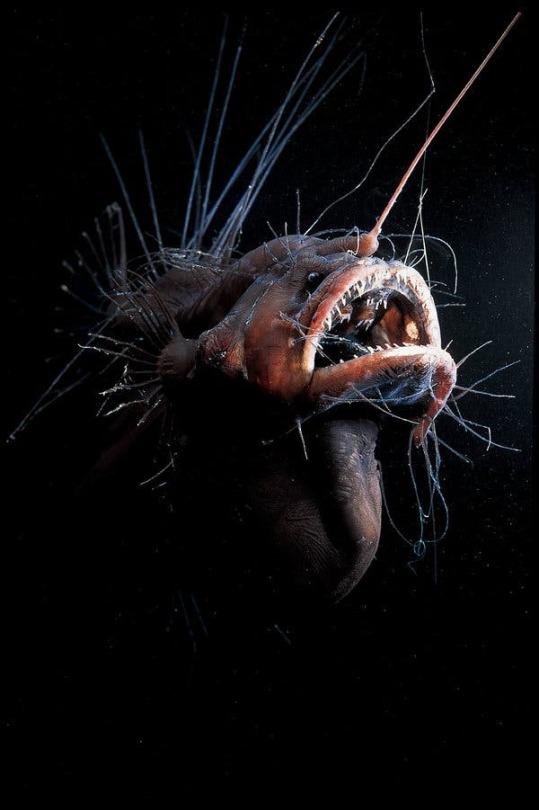
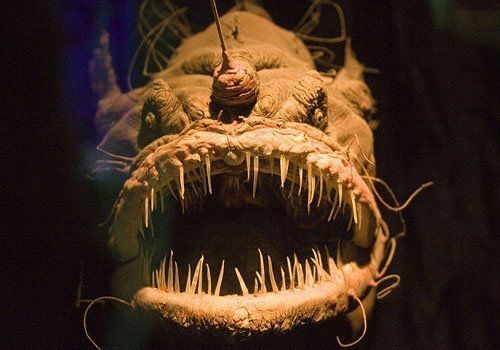
Fanfin Seadevil
Caulophyyne jordani
The Fanfin Seadevil is an ugly, deep fish that is covered in gnarled skin and long sensory filaments. The sensory filaments allow this species of anglerfish to detect movement in the water; this helps the Fanfin find and lure its prey. Furthermore, this deformed monstrosity can be found floating between 700m to 3000m in the ocean.
Photo credit: https://www.nytimes.com/2019/07/29/science/anglerfish-bioluminescence-deep-sea.html
http://www.robotspacebrain.com/alien-creatures-of-the-mariana-trench/


Lav Polyp
leuckartiara octona
The Lav Polypo is a jelly that comes in a variety of colors and shapes; it dwells about 200m in the deep ocean. The red mass inside its translucent bell is the jelly’s reproductive organs. Furthermore, it uses its dull, yellow tentacles can catch unsuspecting prey.
Photo credit: https://www.pinterest.com/pin/65935582019848580/
https://www.petjellyfish.co.uk/shop/live-jellyfish/leuckartiara-octona


Mid-water Arctic Hydrozoan
Botrynema brucei
The Mid-water Arctic Hydrozoan is a mini-jelly that is transparent with hints of blue. It thrives in freezing cold temperatures and drifts aimlessly in the Artic Ocean. Moreover, it is only 3 cm in size and floats between 900m to 2,600m.
Photo credit: https://en.wikipedia.org/wiki/Botrynema_brucei
http://www.arcodiv.org/watercolumn/cnidarian/Botrynema_brucei.html
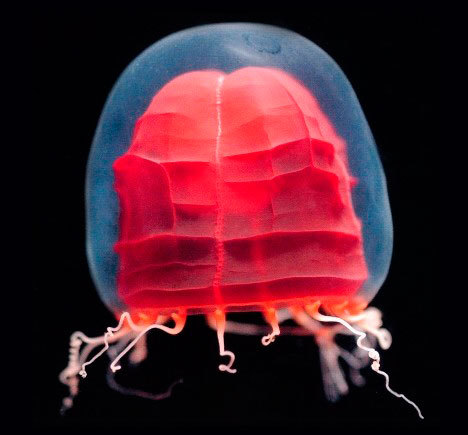

Red Paper Lantern Medusa
Pandea rubra
The Red Paper Lantern resembles a floating, Japanese paper lantern in the deep sea. It has the ability to crumple and wrinkle its bright, red bell, and it is located at depths between 550m to 1200m. It has also been nicknamed the “origami jelly.”
Photo credit: https://commons.wikimedia.org/wiki/Category:Pandea_rubra
http://www.thegorgeousdaily.com/pandea-rubra/